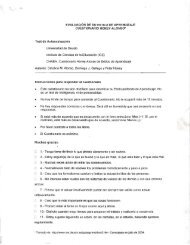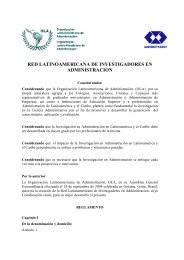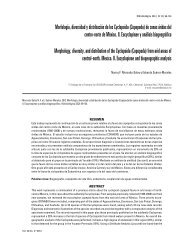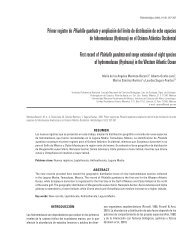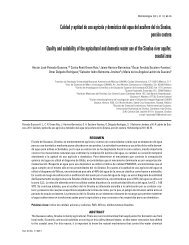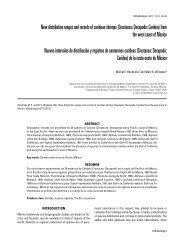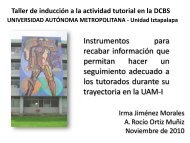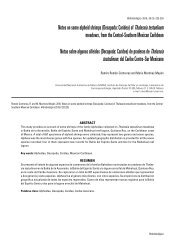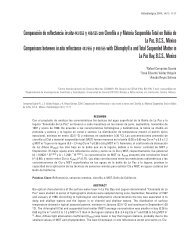Codium decorticatum
Codium decorticatum
Codium decorticatum
- No tags were found...
Create successful ePaper yourself
Turn your PDF publications into a flip-book with our unique Google optimized e-Paper software.
6found a similar disposition of the organelles in <strong>Codium</strong> <strong>decorticatum</strong>,the ecto and endoplasm differentiation was not soobvious.Chloroplasts with numerous thylakoids and scarcestarch granules, similar to those described by Hori and Ueda(1967) in <strong>Codium</strong> fragile and C. repens, were observed in C.<strong>decorticatum</strong>. Moreover, we also observed in the same utriclechloroplasts with reduced thylakoids and one or more ovalstarch granules and plastids almost completely occupied witha large starch granule. Although this variation can not be considereda heteroplasty as occurrs in Caulerpa, Dichotomosiphon,Avrainvillea, Chlorodesmis, Halimeda and Udotea (Horiand Ueda, 1967; Borowitzka, 1976; Roth and Friedmann, 1987),the great variation observed in the number of thylakoids andthe amount of starch in different plastids in the same utriclein <strong>Codium</strong> <strong>decorticatum</strong> is noteworthy.GametogenesisIn 1950, Schussnig studied gametogenesis of C. <strong>decorticatum</strong>at optical level. The present report is the first ultrastructuralstudy of the gametogenesis in the genus. Thedevelopment of gametangia has been studied ultrastructurallyonly in two species of Caulerpales: Derbesia tenuissimaand Bryopsis hypnoides (Wheeler and Page, 1974; Burr andWest, 1970), whereas in Caulerpa racemosa there are studiesonly at the optical microscope level (Enomoto and Ohba,1987).The disposition of gametangia in lines of utricles situatedin the inner side of dichotomies in C. <strong>decorticatum</strong> is describedfor the first time in the genus. In other species of<strong>Codium</strong> the gametangia are disposed mainly at random.Gamete formation in C. <strong>decorticatum</strong> occurred in the cytoplasmof the basal portion of the gametangium; in Bryopsishypnoides, the differentiation of gametes begins in the cytoplasmremaining in the periphery of the gametangium (Burrand West, 1970).In C. <strong>decorticatum</strong> nuclear division took place in the progametangiafollowed by chloroplast division. On the contrary,in Bryopsis hypnoides, the first indication of gamete formationis the simultaneous multiplication of chloroplasts and nuclei(Burr and West, 1970).Miravalles, A. B., et al.In C. <strong>decorticatum</strong> the portions of protoplasm that willgive rise to the gametes are initially delimitated by sphericalelectron translucent aligned vesicles. In Bryopsis hypnoidescleavage takes place also through vesicles but they are large,flattened and aligned around the nucleus (Burr and West,1970). In the case of Derbesia tenuissima and D. marina protoplasmcleavage occurs by proliferation of vacuoles betweenthe organelles (Wheeler and Page, 1974).Gamete discharge in C. <strong>decorticatum</strong> took place throughan operculum. The gametes were released in a stream of aslimy substance as happens in other species of the genus,such as C. fragile, C. tomentosum, C. elongatum and C. bursa(Borden and Stein, 1969b). In other Caulerpales, such as Derbesia,Bryopsis and Caulerpa, gamete release takes place inthe area under a papilla after the dissolution of the wall (Burrand West, 1970; Wheeler and Page, 1974; Enomoto and Ohba,1987).In general, the flagellar apparatus of the gametes of <strong>Codium</strong><strong>decorticatum</strong> resembles that of male gametes of Derbesiatenuissima (Roberts et al., 1981), in the morphology of thecapping plate, the structure and location of the terminal capsand the presence of proximal sheaths. The last feature is neitherdescribed by the authors in D. tenuissima nor in Pseudobryopsissp. (Roberts et al., 1982), although electron denseproximal sheaths subtending the proximal end of the basalbodies were observed in their figures 12 and 8. Terminal capsformed by two orthogonally disposed subunits are also presentin male gametes of Bryopsis maxima and Pseudobryopsissp. (Hori, 1977; Roberts et al., 1982). The last two generaalso possess a capping plate similar to that of C. <strong>decorticatum</strong>;however, in those cases each capping plate half is distallyattached by a fibrous connective (Roberts et al., 1982)instead of by an electron dense material.Just as in all male gametes studied in the Caulerpales(Burr and West, 1970; Gori, 1979; Hori, 1977; Roberts et al.,1981, 1982), C. <strong>decorticatum</strong> gametes presented an anteriorlarge mitochondrion and no eyespot. On the contrary, the femalegametes of the Caulerpales studied, possess severalsmall mitochondria and generally an eyespot (Hori, 1977; Robertset al., 1982).Schussnig (1950) observed male and female gametangiain C. <strong>decorticatum</strong> growing in Mediterranean Sea (NaplesGulf); Kapraun and Martin (1987) presumed also sexual reproductionby anisogametes in the same species in the NorthAtlantic coast (North Carolina); however, we found only onetype of gametangium in the South Atlantic coast. Even thoughSchussnig (1950) does not mention gamete measurements,the nucleus size of South Atlantic coast gametes agrees withthat described by Schussnig for C. <strong>decorticatum</strong> male gametes.Considering also that the fine structure features of C. <strong>decorticatum</strong>gametes agree with those of male gametes ofother siphonous green algae, we can assert that the AtlanticArgentinian populations of C. <strong>decorticatum</strong> produce only onetype of gametes, and that these belong to the male sex.Hidrobiológica



